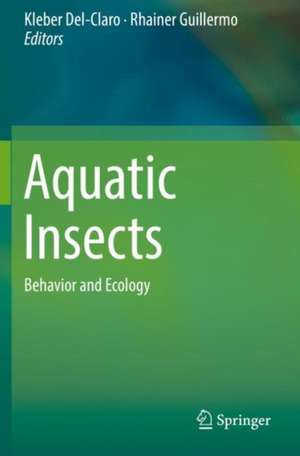Aquatic Insects: Behavior and Ecology
Editat de Kleber Del-Claro, Rhainer Guillermoen Limba Engleză Paperback – 15 aug 2020
This book presents a broad view of the ecology and behavior of aquatic insects, raising awareness of this conspicuous and yet little known fauna that inhabits inland waterbodies such as rivers, lakes and streams, and is particularly abundant and diverse in tropical ecosystems. The chapters address topics such as distribution, dispersal, territoriality, mating behavior, parental care and the role of sensory systems in the response to external and internal cues. In the context of ecology, it discusses aquatic insects as bio indicators that may be used to assess environmental disturbances, either in protected or urban areas, and provides insights into how genetic connectivity can support the development of novel conservation strategies. It also explores how aquatic insects can inspire solutions for various problems faced by modern society, presenting examples in the fields of material science, optics, sensorics and robotics.
| Toate formatele și edițiile | Preț | Express |
|---|---|---|
| Paperback (1) | 1311.72 lei 38-44 zile | |
| Springer International Publishing – 15 aug 2020 | 1311.72 lei 38-44 zile | |
| Hardback (1) | 1565.13 lei 3-5 săpt. | |
| Springer International Publishing – 26 iun 2019 | 1565.13 lei 3-5 săpt. |
Preț: 1311.72 lei
Preț vechi: 1725.95 lei
-24% Nou
Puncte Express: 1968
Preț estimativ în valută:
251.08€ • 272.82$ • 211.04£
251.08€ • 272.82$ • 211.04£
Carte tipărită la comandă
Livrare economică 17-23 aprilie
Preluare comenzi: 021 569.72.76
Specificații
ISBN-13: 9783030163297
ISBN-10: 3030163296
Pagini: 438
Ilustrații: XI, 438 p. 116 illus., 70 illus. in color.
Dimensiuni: 155 x 235 mm
Greutate: 0.81 kg
Ediția:1st ed. 2019
Editura: Springer International Publishing
Colecția Springer
Locul publicării:Cham, Switzerland
ISBN-10: 3030163296
Pagini: 438
Ilustrații: XI, 438 p. 116 illus., 70 illus. in color.
Dimensiuni: 155 x 235 mm
Greutate: 0.81 kg
Ediția:1st ed. 2019
Editura: Springer International Publishing
Colecția Springer
Locul publicării:Cham, Switzerland
Cuprins
1. AQUATIC INSECTS – WHY IT IS IMPORTANT TO DEDICATE OUR TIME ON THEIR STUDY?
2. DISTRIBUTION AND HABITATS OF AQUATIC INSECTS
3. DISPERSAL BY AQUATIC INSECTS
4. Effects of abiotic factors and ecogeographic patterns on the ecology, distribution and behavior of aquatic insects
5. THE BIOTIC ENVIRONMENT: MULTIPLE INTERACTIONS IN AN AQUATIC WORLD
6. DRUMMING FOR LOVE: MATING BEHAVIOR IN STONEFLIES
7. AQUATIC INSECT SENSILLA: MORPHOLOGY AND FUNCTION
8. TERRITORIALITY IN AQUATIC INSECTS
9. DEFENSES OF WATER INSECTS
10. REPRODUCTIVE BEHAVIOR AND SEXUAL SELECTION
11. SEXUAL CONFLICT IN WATER STRIDERS, DRAGONFLIES AND DIVING BEETLES
12. PATERNAL CARE IN GIANT WATER BUGS
13. THE AQUATIC LEPIDOPTERANS: A MYSTERIOUS AND UNKNOWN FAUNA
14. URBAN AQUATIC INSECTS 15. THE TINBERGEN SHORTFALL: DEVELOPMENTS ON AQUATIC INSECT BEHAVIOR THAT ARE CRITICAL FOR FRESHWATER CONSERVATION
16. GENETIC CONNECTIVITY IN CONSERVATION OF FRESHWATER INSECTS
17. AQUATIC INSECTS AS A SOURCE FOR BIOMIMETICS
2. DISTRIBUTION AND HABITATS OF AQUATIC INSECTS
3. DISPERSAL BY AQUATIC INSECTS
4. Effects of abiotic factors and ecogeographic patterns on the ecology, distribution and behavior of aquatic insects
5. THE BIOTIC ENVIRONMENT: MULTIPLE INTERACTIONS IN AN AQUATIC WORLD
6. DRUMMING FOR LOVE: MATING BEHAVIOR IN STONEFLIES
7. AQUATIC INSECT SENSILLA: MORPHOLOGY AND FUNCTION
8. TERRITORIALITY IN AQUATIC INSECTS
9. DEFENSES OF WATER INSECTS
10. REPRODUCTIVE BEHAVIOR AND SEXUAL SELECTION
11. SEXUAL CONFLICT IN WATER STRIDERS, DRAGONFLIES AND DIVING BEETLES
12. PATERNAL CARE IN GIANT WATER BUGS
13. THE AQUATIC LEPIDOPTERANS: A MYSTERIOUS AND UNKNOWN FAUNA
14. URBAN AQUATIC INSECTS 15. THE TINBERGEN SHORTFALL: DEVELOPMENTS ON AQUATIC INSECT BEHAVIOR THAT ARE CRITICAL FOR FRESHWATER CONSERVATION
16. GENETIC CONNECTIVITY IN CONSERVATION OF FRESHWATER INSECTS
17. AQUATIC INSECTS AS A SOURCE FOR BIOMIMETICS
Notă biografică
Kleber Del Claro is an ethologist and full professor at the Federal University of Uberlandia (Brazil). He is an expert in behavioral ecology interactions. His fascination with aquatic insects began ten years ago when he became involved in a project to save the “Veredas,” an endangered aquatic system in the Brazilian savanna.
Rhainer Guillermo has been an entomologist and associate professor at the Federal University of São Carlos since 2015. His research is focused on the biodiversity of Odonata and Plecoptera with an emphasis in morphology, taxonomy, and behavior.
Rhainer Guillermo has been an entomologist and associate professor at the Federal University of São Carlos since 2015. His research is focused on the biodiversity of Odonata and Plecoptera with an emphasis in morphology, taxonomy, and behavior.
Textul de pe ultima copertă
This book presents a broad view of the ecology and behavior of aquatic insects, raising awareness of this conspicuous and yet little known fauna that inhabits inland waterbodies such as rivers, lakes and streams, and is particularly abundant and diverse in tropical ecosystems. The chapters address topics such as distribution, dispersal, territoriality, mating behavior, parental care and the role of sensory systems in the response to external and internal cues. In the context of ecology, it discusses aquatic insects as bio indicators that may be used to assess environmental disturbances, either in protected or urban areas, and provides insights into how genetic connectivity can support the development of novel conservation strategies. It also explores how aquatic insects can inspire solutions for various problems faced by modern society, presenting examples in the fields of material science, optics, sensorics and robotics.
Caracteristici
The first book focusing on the behavioral ecology of aquatic insects in their different life cycles
Discusses biotic and abiotic interactions, sexual selection, and evolution of behavioral strategies
Presents applied case studies where aquatic insects are used as bio indicators of environmental quality and inspire new technologies
Discusses biotic and abiotic interactions, sexual selection, and evolution of behavioral strategies
Presents applied case studies where aquatic insects are used as bio indicators of environmental quality and inspire new technologies
